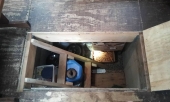





 1
1




Finished one life quest, on to the next!
 5
5




 7
7




 6
6




SKIP books, get 'em while they're hot!!! Skills to Inherit Property
 5
5




 2
2




Mike Haasl wrote:Another way is to leave them in the ground, mulched heavily with hay/straw.








Douglas Alpenstock wrote:
Mike Haasl wrote:Another way is to leave them in the ground, mulched heavily with hay/straw.
I've hear of that. I believe it would work well in areas with milder winters than ours.
SKIP books, get 'em while they're hot!!! Skills to Inherit Property
 3
3




 3
3




Bethany Brown wrote:What’s your climate like? You may be able to leave them in the ground.

 7
7




Works at a residential alternative high school in the Himalayas SECMOL.org . "Back home" is Cape Cod, E Coast USA.




Rebecca Norman wrote:Where I live in the Indian Himalayas, with pretty cold winters (6 weeks of pond hockey), the traditional root storage method was to dig a hole in the garden every year, deep enough so the sacks of roots could be kept below the frost line, which at my location is about 3 feet. So you lower in sacks of potatoes, carrots, radishes or rutabagas, and cover them back over with soil. .
Whathever you are, be a good one.
___________________________________









Works at a residential alternative high school in the Himalayas SECMOL.org . "Back home" is Cape Cod, E Coast USA.
 7
7




 1
1




Rebecca Norman wrote:...root storage method was to dig a hole in the garden every year, deep enough so the sacks of roots could be kept below the frost line...
 4
4




 4
4




 1
1




 1
1




 4
4




 3
3




 5
5





|
Drove my Chevy to the levee but the levee was dry. I wrung this tiny ad and it was still dry.
permaculture and gardener gifts (stocking stuffers?)
https://permies.com/wiki/permaculture-gifts-stocking-stuffers
|

